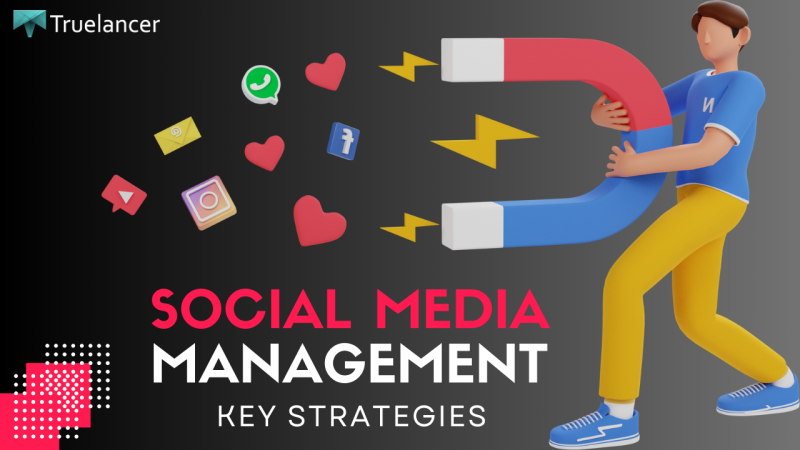Social Media Management: Key Strategies for Success
Welcome to the world of social media management, where connections are made, brands are built, and success awaits. In this blog, we’ll unlock the key strategies that will take your social media game to the next level.
From setting goals to understanding your audience, crafting engaging content to leveraging the right platforms, we’ve got you covered. Get ready to discover insider tips and actionable insights that will transform your social media presence.
Whether you’re a seasoned pro or new to the game, this blog is your ultimate guide. It’s time to elevate your social media strategy, foster meaningful connections, and achieve tangible results.
So, let’s dive into the world of social media management and unleash your full potential. Success awaits one post at a time. Let’s get started!
What is Social media management?
Social media management involves the process of creating, scheduling, analysing, and engaging with content across social media platforms. It includes developing a strategic plan, creating engaging content, scheduling posts, engaging with the audience, analysing performance metrics, and utilizing advertising to achieve marketing goals. It is essential for building brand presence, engaging with customers, and driving business success in the digital age.
Establishing Clear Goals and Objectives

Defining your social media objectives:
To ensure success in social media management, it’s crucial to define your objectives clearly. This involves identifying what you want to achieve through your social media presence, whether it’s increasing brand awareness, driving website traffic, generating leads, or boosting sales. By setting specific, measurable, attainable, relevant, and time-bound (SMART) goals, you provide a clear focus and direction for your social media efforts.
Setting measurable goals for success:
Once you have established your objectives, it’s important to set measurable goals to track your progress. This involves determining the key performance indicators (KPIs) that align with your objectives. For example, if your goal is to increase brand awareness, you might track metrics like social media followers, reach, engagement, and mentions. By regularly monitoring and analysing these metrics, you can assess the effectiveness of your social media strategies and make data-driven decisions to improve your performance.
Identifying and Understanding Your Target Audience

Conducting audience research and analysis:
Understanding your target audience is essential for effective social media management. Conducting thorough audience research allows you to gain insights into their demographics, interests, behaviours, and pain points. You can use tools like social media analytics, customer surveys, and market research to gather data about your audience. By analysing this information, you can create buyer personas that represent your ideal customers. These personas help you humanize and visualize your target audience, enabling you to tailor your content, messaging, and social media strategies to resonate with them.
Creating buyer personas for effective targeting:
Buyer personas are fictional representations of your target customers, based on real data and research. They include details such as age, gender, occupation, interests, goals, challenges, and preferred social media platforms. By developing detailed buyer personas, you gain a deeper understanding of your audience’s needs and preferences. This allows you to create highly targeted and personalized content, engage in relevant conversations, and build stronger connections with your audience.
Developing a Comprehensive Content Strategy

Crafting a content calendar:
A content calendar is a strategic tool that helps you plan and organize your social media content effectively. It outlines what content you will create when it will be published, and on which platforms. By maintaining a content calendar, you ensure a consistent and well-structured approach to content creation, distribution, and scheduling. It enables you to align your content with your business goals, stay organized, and maintain a steady presence on social media.
Creating engaging and shareable content:
To succeed in social media management, it’s crucial to create content that captivates your audience and encourages engagement. This includes various content formats such as text, images, videos, infographics, and interactive elements. Your content should be informative, entertaining, inspiring, or useful to your target audience. It’s important to optimize your content for search engines by using relevant keywords, meta tags, and descriptions. Additionally, creating shareable content encourages your audience to share it with their networks, expanding your reach and visibility.
Utilizing the Right Social Media Platforms

Selecting platforms based on target audience and goals:
With numerous social media platforms available, it’s important to choose the ones that align with your target audience and goals. Each platform caters to a different demographic and user behaviour. For example, if your target audience is predominantly professionals, LinkedIn may be more suitable, while Instagram might be ideal for a younger, visually-oriented audience. By understanding the demographics and characteristics of each platform, you can make informed decisions about where to focus your social media efforts.
Understanding platform-specific best practices:
Each social media platform has its own set of best practices and features that can help you maximize your impact. For example, on Facebook, utilizing engaging visuals, leveraging Facebook Groups, and running targeted ads can be effective strategies. On Instagram, using high-quality images, incorporating hashtags, and leveraging Instagram Stories can help increase engagement. It’s important to understand the unique dynamics of each platform and adapt your content and strategies accordingly to optimize your results.
Building and Growing a Strong Social Media Community

Encouraging engagement and interaction:
One of the keys to social media success is building an engaged and interactive community. Encourage your followers to like, comment, and share your content by asking thought-provoking questions, sparking conversations, and seeking their opinions. Respond to comments and messages promptly and authentically, showing that you value their input and are actively listening. This fosters a sense of community and encourages ongoing engagement.
Implementing strategies to increase followers and reach:
Growing your social media following and expanding your reach is essential for maximizing your impact. Implement strategies such as cross-promotion, where you promote your social media profiles on other channels, like your website or email newsletters. Collaborate with influencers or industry partners to tap into their audience. Run contests or giveaways to incentivize people to follow and engage with your content. Consistently maintain your branding and voice across platforms to build recognition and attract new followers.
Implementing Effective Social Media Advertising

Leveraging paid advertising options:
Social media platforms offer powerful advertising options to reach a wider audience and achieve specific goals. Facebook Ads, Instagram Ads, LinkedIn Ads, and Twitter Ads are popular platforms for targeted advertising. Learn how to create compelling ad campaigns, define your target audience, set budgets, and select the right ad formats. Leverage the advanced targeting capabilities offered by these platforms to reach the most relevant audience for your business.
Targeting and optimizing ad campaigns for maximum ROI:
To maximize the return on your social media advertising investment, it’s important to optimize your ad campaigns continuously. Refine your target audience based on demographics, interests, behaviours, and previous interactions. Test different ad creatives, copy, and calls to action to identify what resonates best with your audience. Monitor your ad performance closely and make data-driven optimizations to improve your click-through rates, conversions, and overall ROI.
Monitoring and Analysing Performance Metrics

Tracking key performance indicators (KPIs):
Key performance indicators are measurable metrics that indicate the success of your social media efforts. Common KPIs include reach, engagement rate, click-through rate, conversion rate, and follower growth. Identify the most relevant KPIs based on your goals and track them regularly to assess your performance and make informed decisions. Use social media analytics tools and built-in platform insights to gather data and track these metrics effectively.
Using analytics tools to measure and evaluate success:
Social media analytics tools like Facebook Insights, Twitter Analytics, and Google Analytics provide detailed data on your social media performance. Utilize these tools to track your KPIs, gain insights into audience demographics and behaviour, measure the effectiveness of your campaigns, and identify areas for improvement. Analyse the data to understand what content performs best, which platforms drive the most engagement, and how your social media efforts contribute to your overall business objectives.
Engaging and Responding to Your Audience

Promptly addressing customer queries and feedback:
Social media provides a direct line of communication with your audience, so it’s important to be responsive. Promptly address customer queries, comments, and feedback to show that you value their input and are committed to providing excellent customer service. Responding in a timely and helpful manner builds trust and fosters a positive relationship with your audience. Consider implementing a social media management tool or setting up notifications to ensure you don’t miss any messages or mentions.
Fostering two-way communication and building relationships:
Social media is not just a one-way broadcasting platform; it’s an opportunity to engage in meaningful conversations with your audience. Encourage dialogue by asking questions, seeking feedback, and actively participating in discussions. Engage with user-generated content by liking, sharing, or commenting on posts created by your audience. By fostering two-way communication, you can build stronger relationships, gain valuable insights, and create a loyal community around your brand.
Staying Up-to-Date with Trends and Industry Best Practices
Keeping abreast of platform updates and algorithm changes:
Social media platforms constantly evolve, introducing new features, algorithms, and policies. Stay informed about the latest updates and changes by following official platform blogs, joining relevant industry groups, and subscribing to social media marketing publications. Being aware of these updates allows you to adapt your strategies and stay ahead of the curve.
Learning from successful case studies and industry leaders:
Study successful social media campaigns, both within your industry and beyond. Analyse what made them effective and apply those learnings to your strategies. Follow thought leaders in the social media management field, attend industry conferences, and participate in webinars or online courses to stay updated on the latest trends and best practices. By learning from other’s successes and failures, you can refine your strategies and achieve better results.
Continuous Testing, Optimization, and Adaptation

A/B testing strategies for content, ads, and targeting:
A/B testing involves creating variations of your content or ads and testing them against each other to identify which performs better. Experiment with different content formats, headlines, visuals, ad copies, and targeting parameters to identify the most effective combinations. Use A/B testing to make data-driven decisions and optimize your social media strategies for better results.
Making data-driven decisions for ongoing improvement:
Regularly review your social media analytics and performance data to identify areas for improvement. Analyze the data to understand what content resonates with your audience, which platforms drive the most engagement, and which strategies deliver the best ROI. Use these insights to refine your content strategy, targeting, and overall social media management approach. By continuously testing, optimizing, and adapting, you can stay ahead of the competition and achieve long-term success.
CONCLUSION
By implementing these key strategies for social media management, you can effectively engage with your target audience, grow your brand presence, and achieve your business goals. Remember to regularly assess your performance, stay informed about industry trends, and continuously optimize your strategies based on data-driven insights.
